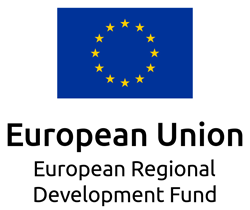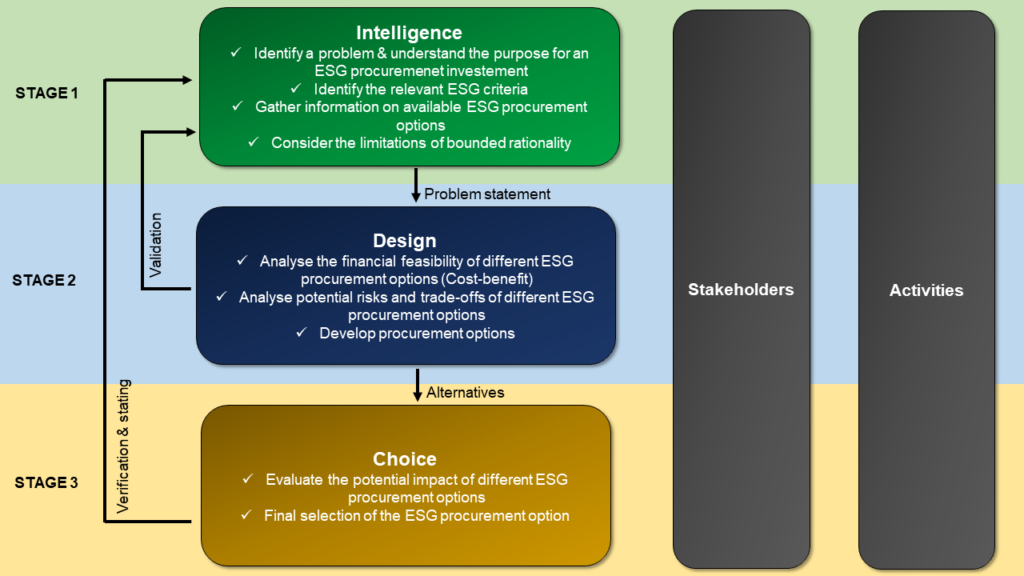Conducting an ESG Decision Process in Procurement: A Step-by-Step
1. The Intelligence Stage: Gathering and Analyzing Data
The ESG procurement process begins with the Intelligence stage, where the primary task is to gather and analyze relevant data to understand market conditions, sustainability challenges, and opportunities. This stage requires procurement teams to collect detailed information on supplier practices, product life cycles, and compliance with sustainability standards. Engaging with stakeholders such as customers, suppliers, and regulatory bodies is also crucial to align the procurement strategy with external expectations and requirements. Additionally, identifying potential ESG risks associated with different procurement options helps in making informed decisions later in the process.
Key Activities:
- Data Collection: Gathering data on supplier practices, product life cycles, and compliance with sustainability standards.
- Stakeholder Consultation: Engaging with stakeholders, including customers, suppliers, and regulatory bodies, to understand their expectations and requirements.
- Risk Assessment: Identifying potential ESG risks associated with procurement choices.
2. The Design Stage: Developing Sustainable Procurement Strategies
Following the comprehensive data collection and analysis, the next phase is the Design stage, where the actual planning of ESG integration into procurement practices takes place. Here, procurement strategies are developed to embed ESG criteria effectively within the organizational procurement policies. This involves not only creating policies that enforce ESG compliance but also engaging suppliers to improve their ESG performance. Training and resource provision become key components in empowering suppliers to meet the established ESG standards. The strategies crafted in this stage aim to balance cost, efficiency, and sustainability in a way that aligns with the organization’s overall sustainability goals.
Key Activities:
- Strategy Formulation: Developing procurement strategies that integrate ESG criteria into selection processes.
- Supplier Engagement: Working with suppliers to enhance their ESG performance, including offering training and resources to help them meet the organization’s standards.
- Policy Development: Establishing procurement policies that enforce ESG compliance.
3. The Choice Stage: Making Informed Procurement Decisions
The final stage, Choice, involves making the actual procurement decisions. This stage is the culmination of all the planning and strategizing, where options are evaluated and decisions are implemented. The procurement team assesses suppliers based on their ability to meet the ESG standards previously set and their overall impact on the organization’s sustainability goals. Effective contract negotiations are crucial here, as they ensure that ESG priorities and commitments are clearly reflected in procurement contracts. Lastly, establishing mechanisms for ongoing monitoring and reporting on supplier performance against ESG criteria is essential for ensuring long-term compliance and improvement.
Key Activities:
- Evaluation and Selection: Assessing suppliers based on their ability to meet ESG standards and their overall impact on sustainability goals.
- Contract Negotiation: Ensuring that contracts reflect ESG priorities and commitments.
- Monitoring and Reporting: Establishing mechanisms for ongoing monitoring of supplier performance against ESG criteria.
Challenges and Solutions of Sustainable Procurement
Common challenges in integrating ESG into procurement include aligning costs with sustainability goals, overcoming limited awareness among stakeholders, and dealing with data availability issues. Solutions involve continuous education and training for stakeholders, investing in technology to improve data collection and analysis, and developing partnerships with suppliers who also commit to sustainability practices.
ESG strategies are integral for making informed procurement decisions that not only meet financial objectives but also advance corporate sustainability goals. By embracing ESG considerations, companies can enhance their market competitiveness, foster consumer trust, and contribute positively to global sustainability efforts.
For companies looking to start or improve their ESG strategy, it is crucial to adopt a structured approach to integrate ESG considerations consistently across all procurement activities. Engaging with experts, leveraging technology, and continuous monitoring and adaptation of ESG strategies are essential steps towards achieving sustainable procurement excellence.
Risk Management in ESG
Effective risk management is central to successful ESG procurement, especially under the regulatory frameworks like LkSG. In this context, companies are required to establish a diligent risk management system that includes conducting thorough risk analyses and defining clear responsibilities for overseeing risk management practices. This system must be capable of identifying, assessing, and prioritizing ESG risks that could impact operations and supply chains. To aid in these tasks, companies can leverage technology solutions such as the IntegrityNext platform integrated within the Ivalua procurement system. This technology facilitates real-time monitoring and management of compliance with both ESG criteria and the specific requirements of LkSG, such as monitoring for forced labor or environmental abuses within the supply chain. By using these tools, companies can ensure that their risk management processes are not only compliant with current regulations but are also robust enough to adapt to future changes in the legal landscape. Furthermore, these systems enable businesses to implement corrective actions swiftly and effectively, thereby minimizing potential disruptions and enhancing overall sustainability performance.
Integrating LkSG Compliance into ESG Strategy
The implementation of the German Supply Chain Due Diligence Act (LkSG) has introduced a new layer of regulatory compliance that significantly impacts how companies manage their ESG responsibilities. The LkSG requires businesses operating in Germany with a significant number of employees to ensure that human rights and environmental standards are maintained not only within their own operations but throughout their global supply chains. By integrating LkSG compliance into ESG strategies, companies must develop and document comprehensive policies that address human rights strategies and risk management procedures. These policies are made public and include preventative and remedial measures based on risk analyses. This proactive approach allows companies to stay ahead of legal requirements and aligns with broader ESG goals by promoting sustainable practices and ethical governance. The focus on human rights and environmental concerns under the LkSG ensures that companies are held accountable, thus significantly elevating the integrity and transparency of their ESG initiatives.
Supplier Risk Management in Ivalua
Are you ready to elevate your company’s ESG strategy and ensure compliance with the latest regulations, including the German Supply Chain Due Diligence Act (LkSG)? Discover how our integration of the IntegrityNext platform with Ivalua’s procurement solutions can transform your supply chain management.
IntegrityNext is a robust platform designed to help businesses like yours effectively monitor and manage compliance across all supply chain activities. It focuses on ESG criteria and specifically addresses the requirements of the LkSG. With this powerful tool, you can automate the essential processes of data collection and analysis, improve visibility into your suppliers’ practices, and ensure that your procurement decisions are fully aligned with both your corporate ESG strategies and stringent legal compliance standards.











